2025届高考英语二轮复习知识点专题一 定语从句 讲义
文档属性
| 名称 | 2025届高考英语二轮复习知识点专题一 定语从句 讲义 | 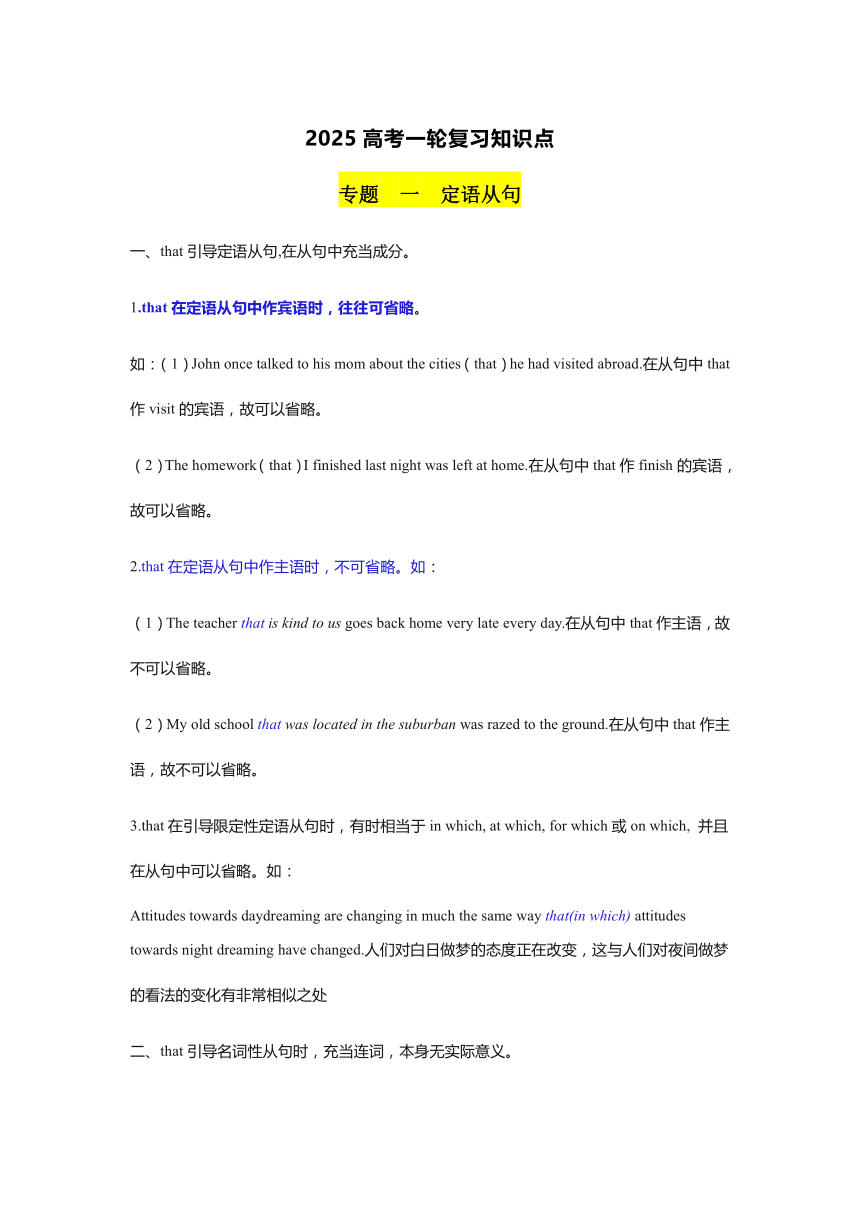 | |
| 格式 | docx | ||
| 文件大小 | 27.1KB | ||
| 资源类型 | 教案 | ||
| 版本资源 | 人教版(2019) | ||
| 科目 | 英语 | ||
| 更新时间 | 2025-01-16 15:17:07 | ||
图片预览

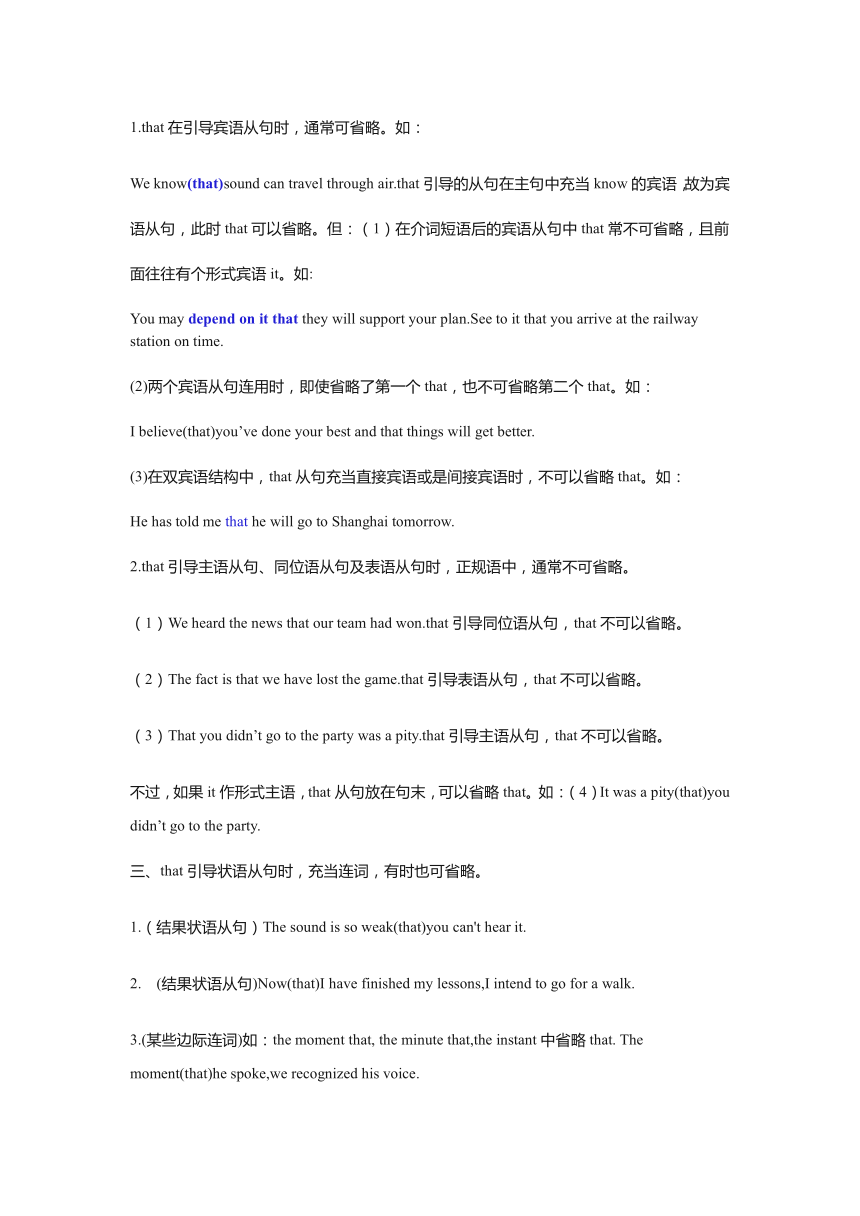
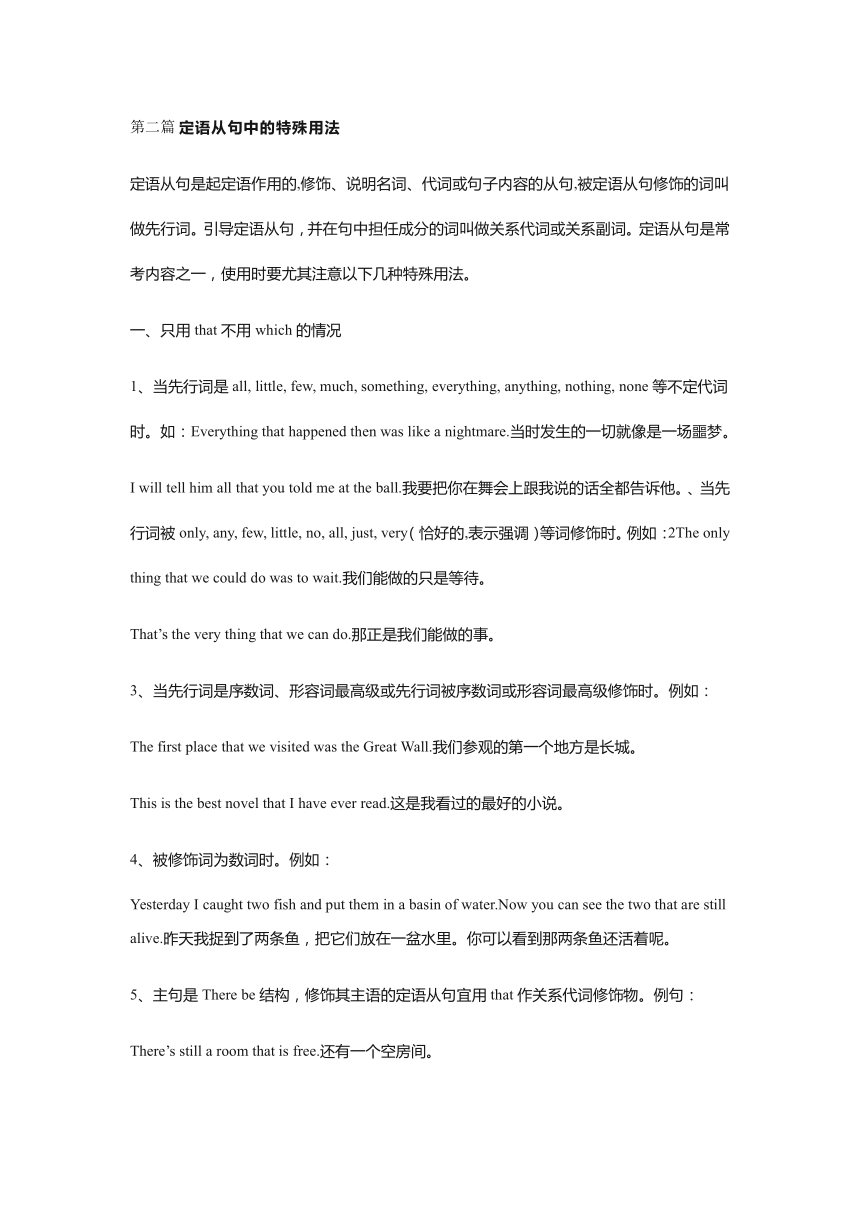
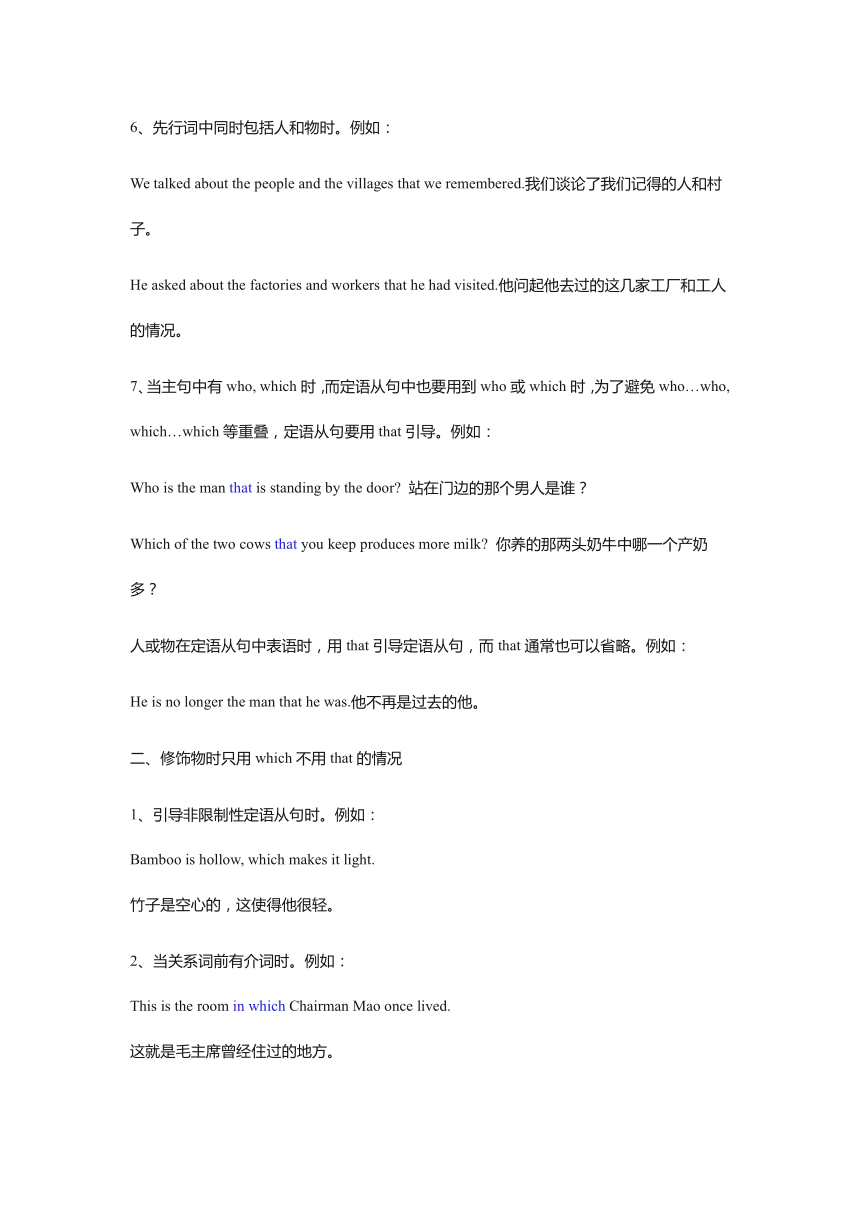
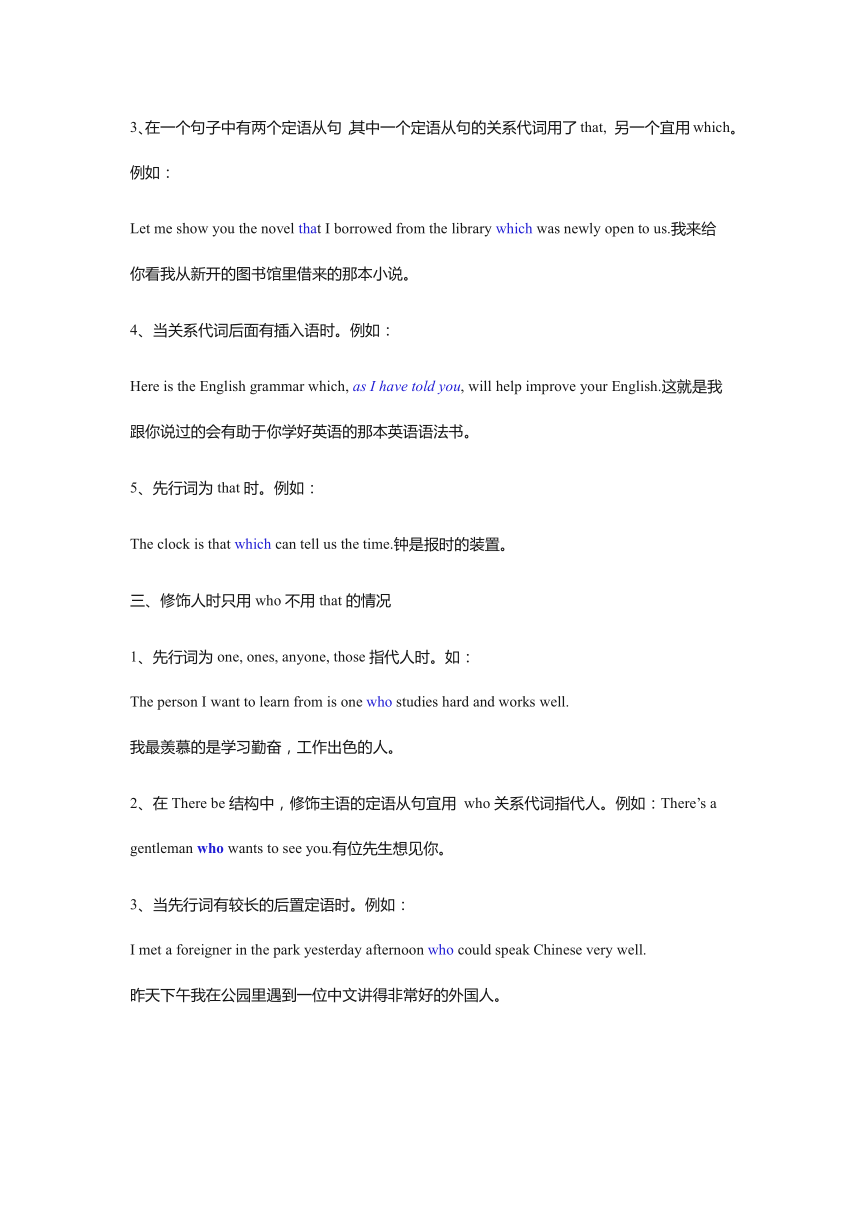
文档简介
2025高考一轮复习知识点
专题 一 定语从句
一、that引导定语从句,在从句中充当成分。
1.that在定语从句中作宾语时,往往可省略。
如:(1)John once talked to his mom about the cities(that)he had visited abroad.在从句中that作visit的宾语,故可以省略。
(2)The homework(that)I finished last night was left at home.在从句中that作finish的宾语,故可以省略。
2.that在定语从句中作主语时,不可省略。如:
(1)The teacher that is kind to us goes back home very late every day.在从句中that作主语,故不可以省略。
(2)My old school that was located in the suburban was razed to the ground.在从句中that作主语,故不可以省略。
3.that在引导限定性定语从句时,有时相当于in which, at which, for which或on which, 并且在从句中可以省略。如:
Attitudes towards daydreaming are changing in much the same way that(in which) attitudes towards night dreaming have changed.人们对白日做梦的态度正在改变,这与人们对夜间做梦的看法的变化有非常相似之处
二、that引导名词性从句时,充当连词,本身无实际意义。
1.that在引导宾语从句时,通常可省略。如:
We know(that)sound can travel through air.that引导的从句在主句中充当know的宾语,故为宾语从句,此时that可以省略。但:(1)在介词短语后的宾语从句中that常不可省略,且前面往往有个形式宾语it。如:
You may depend on it that they will support your plan.See to it that you arrive at the railway station on time.
(2)两个宾语从句连用时,即使省略了第一个that,也不可省略第二个that。如:
I believe(that)you’ve done your best and that things will get better.
(3)在双宾语结构中,that从句充当直接宾语或是间接宾语时,不可以省略that。如:
He has told me that he will go to Shanghai tomorrow.
2.that引导主语从句、同位语从句及表语从句时,正规语中,通常不可省略。
(1)We heard the news that our team had won.that引导同位语从句,that不可以省略。
(2)The fact is that we have lost the game.that引导表语从句,that不可以省略。
(3)That you didn’t go to the party was a pity.that引导主语从句,that不可以省略。
不过,如果it作形式主语,that从句放在句末,可以省略that。如:(4)It was a pity(that)you didn’t go to the party.
三、that引导状语从句时,充当连词,有时也可省略。
1.(结果状语从句)The sound is so weak(that)you can't hear it.
2. (结果状语从句)Now(that)I have finished my lessons,I intend to go for a walk.
3.(某些边际连词)如:the moment that, the minute that,the instant中省略that. The moment(that)he spoke,we recognized his voice.
第二篇 定语从句中的特殊用法
定语从句是起定语作用的,修饰、说明名词、代词或句子内容的从句,被定语从句修饰的词叫做先行词。引导定语从句,并在句中担任成分的词叫做关系代词或关系副词。定语从句是常考内容之一,使用时要尤其注意以下几种特殊用法。
一、只用that不用which的情况
1、当先行词是all, little, few, much, something, everything, anything, nothing, none等不定代词时。如:Everything that happened then was like a nightmare.当时发生的一切就像是一场噩梦。
I will tell him all that you told me at the ball.我要把你在舞会上跟我说的话全都告诉他。、当先行词被only, any, few, little, no, all, just, very(恰好的,表示强调)等词修饰时。例如:2The only thing that we could do was to wait.我们能做的只是等待。
That’s the very thing that we can do.那正是我们能做的事。
3、当先行词是序数词、形容词最高级或先行词被序数词或形容词最高级修饰时。例如:
The first place that we visited was the Great Wall.我们参观的第一个地方是长城。
This is the best novel that I have ever read.这是我看过的最好的小说。
4、被修饰词为数词时。例如:
Yesterday I caught two fish and put them in a basin of water.Now you can see the two that are still alive.昨天我捉到了两条鱼,把它们放在一盆水里。你可以看到那两条鱼还活着呢。
5、主句是There be结构,修饰其主语的定语从句宜用that作关系代词修饰物。例句:
There’s still a room that is free.还有一个空房间。
6、先行词中同时包括人和物时。例如:
We talked about the people and the villages that we remembered.我们谈论了我们记得的人和村子。
He asked about the factories and workers that he had visited.他问起他去过的这几家工厂和工人的情况。
7、当主句中有who, which时,而定语从句中也要用到who或which时,为了避免who…who, which…which等重叠,定语从句要用that引导。例如:
Who is the man that is standing by the door 站在门边的那个男人是谁?
Which of the two cows that you keep produces more milk 你养的那两头奶牛中哪一个产奶多?
人或物在定语从句中表语时,用that引导定语从句,而that通常也可以省略。例如:
He is no longer the man that he was.他不再是过去的他。
二、修饰物时只用which不用that的情况
1、引导非限制性定语从句时。例如:
Bamboo is hollow, which makes it light.
竹子是空心的,这使得他很轻。
2、当关系词前有介词时。例如:
This is the room in which Chairman Mao once lived.
这就是毛主席曾经住过的地方。
3、在一个句子中有两个定语从句,其中一个定语从句的关系代词用了that, 另一个宜用which。例如:
Let me show you the novel that I borrowed from the library which was newly open to us.我来给你看我从新开的图书馆里借来的那本小说。
4、当关系代词后面有插入语时。例如:
Here is the English grammar which, as I have told you, will help improve your English.这就是我跟你说过的会有助于你学好英语的那本英语语法书。
5、先行词为that时。例如:
The clock is that which can tell us the time.钟是报时的装置。
三、修饰人时只用who不用that的情况
1、先行词为one, ones, anyone, those指代人时。如:
The person I want to learn from is one who studies hard and works well.
我最羡慕的是学习勤奋,工作出色的人。
2、在There be结构中,修饰主语的定语从句宜用 who关系代词指代人。例如:There’s a gentleman who wants to see you.有位先生想见你。
3、当先行词有较长的后置定语时。例如:
I met a foreigner in the park yesterday afternoon who could speak Chinese very well.
昨天下午我在公园里遇到一位中文讲得非常好的外国人。
4、一个句子中带有两个定语从句,其中一个定语从句的关系代词是that, 另一个宜用who以避免重复。The student that was praised at yesterday’s meeting is the monitor who is very modest and works very hard.受到校长表扬的学生是位谦虚好学的班长。
注意:当关系代词前面有介词时,只能用whom。例如:
The person to whom this letter was addressed died three years ago.这封信的收信人三年前就去世了。
四、way在定语从句作先行词的用法
当先行词为way时,定语从句的引导词可用in which, that或省略引导词。例如:
I don’t like the way(that /in which)he looks at me.我不喜欢他那种样子看着我。
五、在定语从句中作状语的关系副词when, where, why的用法
1、先行词表示时间时,定语从句中的谓语动词如果是不及物动词,用关系副词when或介词+ which;如果是及物动词,用which或that都行。例如:
I still remember the days when(=on which)we lived together.我仍然记得我们在一起的时光。
2、先行词表示地点时,如果定语从句中谓语动词是不及物动词,用关系副词where或介词+which;如果是及物动词时,用which或that都可以。例如:
This is the small village where(=in which)Chairman Mao ever lived.这就是毛主席曾经居住过的小村庄。
表示原因时,why前的先行词是表示原因的名词reason。例如:
Can you tell me the reason why(=for which)you didn’t finish your homework 你能告诉我你没有完成作业的原因吗?
六、whose引导的定语从句
Whose引导定语从句时,其先行词可以指人,也可以指物,当先行词指物时,可以用the+名词+of which的结构。例如:
He studies in a school whose buildings(=the buildings of which)are built on top of a hill.他就读的学校其房子都建在山顶上。
七、as作关系代词引导的定语从句
1、引导限制性定语从句。在主句中常有the same, so或such与as相呼应, as在定语从句中可作主语、宾语、主语补足语等。as引出的定语从句带有比较意义,从句常常只写出比较部分,但as本身不可省略。例如:
He used such expressions as he could find in the texts.他使用在课文中可以找到的那些词语。
They stayed for the night in the same room as they had once rented.他们在他们曾租用过的同一房间过夜。
注意:在the same…后也可用that引导定语从句,但含义有所不同。that引出的从句,指的是与先行词同一的事物,而as引导的从句指的是与先行词同类的事物。例如:
This is the same bag as I lost yesterday.这个包和我昨天丢失的包的样子是同样的。
This is the same bag that I lost yesterday.这就是我昨天丢失的那个包。
2、引导非限制性定语从句。带主句的全部或部分内容。常译为“正如-------”“就像------”等,定语从句可以置于主句句首、句中或句末。as后常接expect, know, report, say, see等动词的主、被动语态。例如:
As is known to everybody, the moon travels round the earth once every month.正如大家所知道的那样,月球每月绕着地球转一圈。
He wasn’t unconscious, as could be judged from his eyes.他并未失去知觉,这从他的眼神可以看出来。
注意:as, which引导非限制性定语从句的区别:
1)、都可以代整个主句,相当于and this或and that.2)、as可放在句首,而which不能。
3)、as代表前面的整个主句并在从句中作主语时,从句中的谓语必须是系动词;如果为行为动词,则从句中的关系代词只能用which.例如:
It rained hard yesterday, which prevented me from going to the park.昨天下大雨,这使得我不能去公园。
八、of短语作为定语从句的先行词的情况
one of the +复数名词这一结构后面的定语从句中的谓语动词,通常用复数形式,与定语从句所靠近的那个复数名词在数上保持一致。但如果one of the+复数名词这一结构前面带有the/only/the only之类的限定语,从句的谓语动词则要用单数形式,此时从句在意义上修饰的 是the one.例如:
Tom is one of the boys who were late that morning.汤姆是那天早晨迟到的男生之一。
Tom is the(only/the only)one of the boys who was late that morning.汤姆是那天早上唯一迟到的男生。
九、that有时可用作关系副词来代替when, 引导一个定语从句,修饰表示时间的名词,如day, time, moment等。例如:
I arrived here the day that(=when)he left.我是在他离开的那天到达这儿的。
He worked hard the whole time that(=when)he lived here.他在这里的整个时间工作都很努力。
十、than和but也可用作关系代词引导定语从句
1、than用作关系代词,在定语从句中作主语或宾语。例如:
You spent more money than was intended to be spent.你花的钱超过了预定的数额。(than是关系代词,在句中作主语,其先行词是money)
2、but作为关系代词引导定语从句时,一般同具有否定意义的主句连用,其先行词可以是人,也可以是物,但只用于限制性定语从句中。例如:
There was not a single student in my class but learnt a lot from him.(but=who did not)我班上每一个学生都从他那里学到了很多东西。
因此,在这种句子中,but在意义上等于“that...not”,“who...not”,“which...not”。
十一、修饰物体时关系代词that和 which的区分
(一)使用that的情况:
1.当先行词是nothing, something, anything, all, each等不定代词时。e.g.Do you have anything that is important to tell me
2.当先行词被all, any, some, no, not, every, each等修饰时。
e.g.I have some books that are very good.
3.当先行词被形容词最高级、序数词所修饰时。e.g.This is the first book that I bought myself.The biggest bird that I caught is this bird.
4.主句是以which或who开头的特殊疑问句时 e.g.Which is the bike that you lost Who is the woman that was praised at the meeting.
5.当先行词在从句和主句中都作表语时,无论先行词是人还是物.China is no longer the country that she was.
6.如有两个定语从句,其中一个已用which引导,另一个宜用that.Edison built up a factory which produced things that had never been seen before.
7.在there be句型中,只用that.He asked for the latest book(that)there is on the subject.
8.当先行词被the very, the last, the next, the only 等词修饰时。e.g.This is the very book that I lost yesterday.
9.当先行词又有人又有物时。
e.g.I won’t forget the things and the persons that I saw.
(二)只能使用which的情况。
1、非限制性定语从句中。
e.g.Mary has a book, which is very precious.
2、在介词之后。
e.g.This is a house in which lives an old man.
3、当主句中的主语被that修饰时。
e.g.That dog which I found in the street belongs to Mary.
专题 一 定语从句
一、that引导定语从句,在从句中充当成分。
1.that在定语从句中作宾语时,往往可省略。
如:(1)John once talked to his mom about the cities(that)he had visited abroad.在从句中that作visit的宾语,故可以省略。
(2)The homework(that)I finished last night was left at home.在从句中that作finish的宾语,故可以省略。
2.that在定语从句中作主语时,不可省略。如:
(1)The teacher that is kind to us goes back home very late every day.在从句中that作主语,故不可以省略。
(2)My old school that was located in the suburban was razed to the ground.在从句中that作主语,故不可以省略。
3.that在引导限定性定语从句时,有时相当于in which, at which, for which或on which, 并且在从句中可以省略。如:
Attitudes towards daydreaming are changing in much the same way that(in which) attitudes towards night dreaming have changed.人们对白日做梦的态度正在改变,这与人们对夜间做梦的看法的变化有非常相似之处
二、that引导名词性从句时,充当连词,本身无实际意义。
1.that在引导宾语从句时,通常可省略。如:
We know(that)sound can travel through air.that引导的从句在主句中充当know的宾语,故为宾语从句,此时that可以省略。但:(1)在介词短语后的宾语从句中that常不可省略,且前面往往有个形式宾语it。如:
You may depend on it that they will support your plan.See to it that you arrive at the railway station on time.
(2)两个宾语从句连用时,即使省略了第一个that,也不可省略第二个that。如:
I believe(that)you’ve done your best and that things will get better.
(3)在双宾语结构中,that从句充当直接宾语或是间接宾语时,不可以省略that。如:
He has told me that he will go to Shanghai tomorrow.
2.that引导主语从句、同位语从句及表语从句时,正规语中,通常不可省略。
(1)We heard the news that our team had won.that引导同位语从句,that不可以省略。
(2)The fact is that we have lost the game.that引导表语从句,that不可以省略。
(3)That you didn’t go to the party was a pity.that引导主语从句,that不可以省略。
不过,如果it作形式主语,that从句放在句末,可以省略that。如:(4)It was a pity(that)you didn’t go to the party.
三、that引导状语从句时,充当连词,有时也可省略。
1.(结果状语从句)The sound is so weak(that)you can't hear it.
2. (结果状语从句)Now(that)I have finished my lessons,I intend to go for a walk.
3.(某些边际连词)如:the moment that, the minute that,the instant中省略that. The moment(that)he spoke,we recognized his voice.
第二篇 定语从句中的特殊用法
定语从句是起定语作用的,修饰、说明名词、代词或句子内容的从句,被定语从句修饰的词叫做先行词。引导定语从句,并在句中担任成分的词叫做关系代词或关系副词。定语从句是常考内容之一,使用时要尤其注意以下几种特殊用法。
一、只用that不用which的情况
1、当先行词是all, little, few, much, something, everything, anything, nothing, none等不定代词时。如:Everything that happened then was like a nightmare.当时发生的一切就像是一场噩梦。
I will tell him all that you told me at the ball.我要把你在舞会上跟我说的话全都告诉他。、当先行词被only, any, few, little, no, all, just, very(恰好的,表示强调)等词修饰时。例如:2The only thing that we could do was to wait.我们能做的只是等待。
That’s the very thing that we can do.那正是我们能做的事。
3、当先行词是序数词、形容词最高级或先行词被序数词或形容词最高级修饰时。例如:
The first place that we visited was the Great Wall.我们参观的第一个地方是长城。
This is the best novel that I have ever read.这是我看过的最好的小说。
4、被修饰词为数词时。例如:
Yesterday I caught two fish and put them in a basin of water.Now you can see the two that are still alive.昨天我捉到了两条鱼,把它们放在一盆水里。你可以看到那两条鱼还活着呢。
5、主句是There be结构,修饰其主语的定语从句宜用that作关系代词修饰物。例句:
There’s still a room that is free.还有一个空房间。
6、先行词中同时包括人和物时。例如:
We talked about the people and the villages that we remembered.我们谈论了我们记得的人和村子。
He asked about the factories and workers that he had visited.他问起他去过的这几家工厂和工人的情况。
7、当主句中有who, which时,而定语从句中也要用到who或which时,为了避免who…who, which…which等重叠,定语从句要用that引导。例如:
Who is the man that is standing by the door 站在门边的那个男人是谁?
Which of the two cows that you keep produces more milk 你养的那两头奶牛中哪一个产奶多?
人或物在定语从句中表语时,用that引导定语从句,而that通常也可以省略。例如:
He is no longer the man that he was.他不再是过去的他。
二、修饰物时只用which不用that的情况
1、引导非限制性定语从句时。例如:
Bamboo is hollow, which makes it light.
竹子是空心的,这使得他很轻。
2、当关系词前有介词时。例如:
This is the room in which Chairman Mao once lived.
这就是毛主席曾经住过的地方。
3、在一个句子中有两个定语从句,其中一个定语从句的关系代词用了that, 另一个宜用which。例如:
Let me show you the novel that I borrowed from the library which was newly open to us.我来给你看我从新开的图书馆里借来的那本小说。
4、当关系代词后面有插入语时。例如:
Here is the English grammar which, as I have told you, will help improve your English.这就是我跟你说过的会有助于你学好英语的那本英语语法书。
5、先行词为that时。例如:
The clock is that which can tell us the time.钟是报时的装置。
三、修饰人时只用who不用that的情况
1、先行词为one, ones, anyone, those指代人时。如:
The person I want to learn from is one who studies hard and works well.
我最羡慕的是学习勤奋,工作出色的人。
2、在There be结构中,修饰主语的定语从句宜用 who关系代词指代人。例如:There’s a gentleman who wants to see you.有位先生想见你。
3、当先行词有较长的后置定语时。例如:
I met a foreigner in the park yesterday afternoon who could speak Chinese very well.
昨天下午我在公园里遇到一位中文讲得非常好的外国人。
4、一个句子中带有两个定语从句,其中一个定语从句的关系代词是that, 另一个宜用who以避免重复。The student that was praised at yesterday’s meeting is the monitor who is very modest and works very hard.受到校长表扬的学生是位谦虚好学的班长。
注意:当关系代词前面有介词时,只能用whom。例如:
The person to whom this letter was addressed died three years ago.这封信的收信人三年前就去世了。
四、way在定语从句作先行词的用法
当先行词为way时,定语从句的引导词可用in which, that或省略引导词。例如:
I don’t like the way(that /in which)he looks at me.我不喜欢他那种样子看着我。
五、在定语从句中作状语的关系副词when, where, why的用法
1、先行词表示时间时,定语从句中的谓语动词如果是不及物动词,用关系副词when或介词+ which;如果是及物动词,用which或that都行。例如:
I still remember the days when(=on which)we lived together.我仍然记得我们在一起的时光。
2、先行词表示地点时,如果定语从句中谓语动词是不及物动词,用关系副词where或介词+which;如果是及物动词时,用which或that都可以。例如:
This is the small village where(=in which)Chairman Mao ever lived.这就是毛主席曾经居住过的小村庄。
表示原因时,why前的先行词是表示原因的名词reason。例如:
Can you tell me the reason why(=for which)you didn’t finish your homework 你能告诉我你没有完成作业的原因吗?
六、whose引导的定语从句
Whose引导定语从句时,其先行词可以指人,也可以指物,当先行词指物时,可以用the+名词+of which的结构。例如:
He studies in a school whose buildings(=the buildings of which)are built on top of a hill.他就读的学校其房子都建在山顶上。
七、as作关系代词引导的定语从句
1、引导限制性定语从句。在主句中常有the same, so或such与as相呼应, as在定语从句中可作主语、宾语、主语补足语等。as引出的定语从句带有比较意义,从句常常只写出比较部分,但as本身不可省略。例如:
He used such expressions as he could find in the texts.他使用在课文中可以找到的那些词语。
They stayed for the night in the same room as they had once rented.他们在他们曾租用过的同一房间过夜。
注意:在the same…后也可用that引导定语从句,但含义有所不同。that引出的从句,指的是与先行词同一的事物,而as引导的从句指的是与先行词同类的事物。例如:
This is the same bag as I lost yesterday.这个包和我昨天丢失的包的样子是同样的。
This is the same bag that I lost yesterday.这就是我昨天丢失的那个包。
2、引导非限制性定语从句。带主句的全部或部分内容。常译为“正如-------”“就像------”等,定语从句可以置于主句句首、句中或句末。as后常接expect, know, report, say, see等动词的主、被动语态。例如:
As is known to everybody, the moon travels round the earth once every month.正如大家所知道的那样,月球每月绕着地球转一圈。
He wasn’t unconscious, as could be judged from his eyes.他并未失去知觉,这从他的眼神可以看出来。
注意:as, which引导非限制性定语从句的区别:
1)、都可以代整个主句,相当于and this或and that.2)、as可放在句首,而which不能。
3)、as代表前面的整个主句并在从句中作主语时,从句中的谓语必须是系动词;如果为行为动词,则从句中的关系代词只能用which.例如:
It rained hard yesterday, which prevented me from going to the park.昨天下大雨,这使得我不能去公园。
八、of短语作为定语从句的先行词的情况
one of the +复数名词这一结构后面的定语从句中的谓语动词,通常用复数形式,与定语从句所靠近的那个复数名词在数上保持一致。但如果one of the+复数名词这一结构前面带有the/only/the only之类的限定语,从句的谓语动词则要用单数形式,此时从句在意义上修饰的 是the one.例如:
Tom is one of the boys who were late that morning.汤姆是那天早晨迟到的男生之一。
Tom is the(only/the only)one of the boys who was late that morning.汤姆是那天早上唯一迟到的男生。
九、that有时可用作关系副词来代替when, 引导一个定语从句,修饰表示时间的名词,如day, time, moment等。例如:
I arrived here the day that(=when)he left.我是在他离开的那天到达这儿的。
He worked hard the whole time that(=when)he lived here.他在这里的整个时间工作都很努力。
十、than和but也可用作关系代词引导定语从句
1、than用作关系代词,在定语从句中作主语或宾语。例如:
You spent more money than was intended to be spent.你花的钱超过了预定的数额。(than是关系代词,在句中作主语,其先行词是money)
2、but作为关系代词引导定语从句时,一般同具有否定意义的主句连用,其先行词可以是人,也可以是物,但只用于限制性定语从句中。例如:
There was not a single student in my class but learnt a lot from him.(but=who did not)我班上每一个学生都从他那里学到了很多东西。
因此,在这种句子中,but在意义上等于“that...not”,“who...not”,“which...not”。
十一、修饰物体时关系代词that和 which的区分
(一)使用that的情况:
1.当先行词是nothing, something, anything, all, each等不定代词时。e.g.Do you have anything that is important to tell me
2.当先行词被all, any, some, no, not, every, each等修饰时。
e.g.I have some books that are very good.
3.当先行词被形容词最高级、序数词所修饰时。e.g.This is the first book that I bought myself.The biggest bird that I caught is this bird.
4.主句是以which或who开头的特殊疑问句时 e.g.Which is the bike that you lost Who is the woman that was praised at the meeting.
5.当先行词在从句和主句中都作表语时,无论先行词是人还是物.China is no longer the country that she was.
6.如有两个定语从句,其中一个已用which引导,另一个宜用that.Edison built up a factory which produced things that had never been seen before.
7.在there be句型中,只用that.He asked for the latest book(that)there is on the subject.
8.当先行词被the very, the last, the next, the only 等词修饰时。e.g.This is the very book that I lost yesterday.
9.当先行词又有人又有物时。
e.g.I won’t forget the things and the persons that I saw.
(二)只能使用which的情况。
1、非限制性定语从句中。
e.g.Mary has a book, which is very precious.
2、在介词之后。
e.g.This is a house in which lives an old man.
3、当主句中的主语被that修饰时。
e.g.That dog which I found in the street belongs to Mary.
